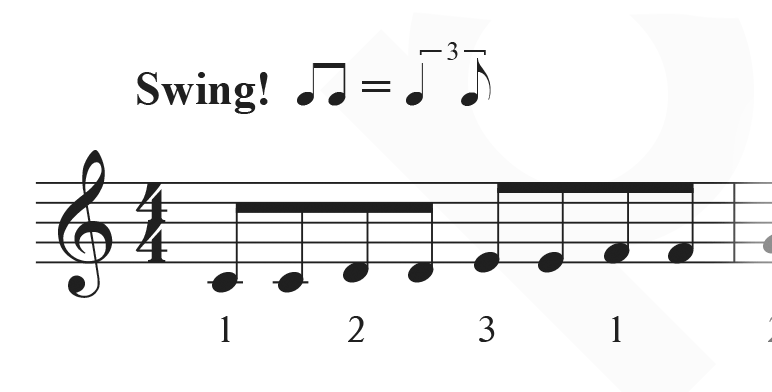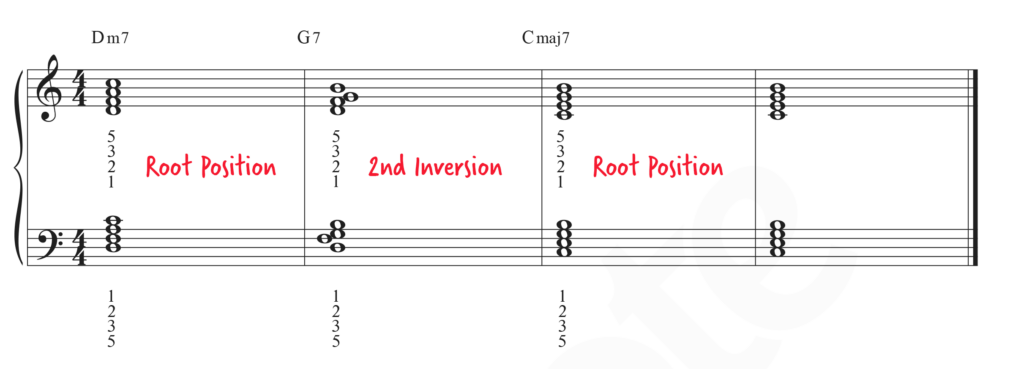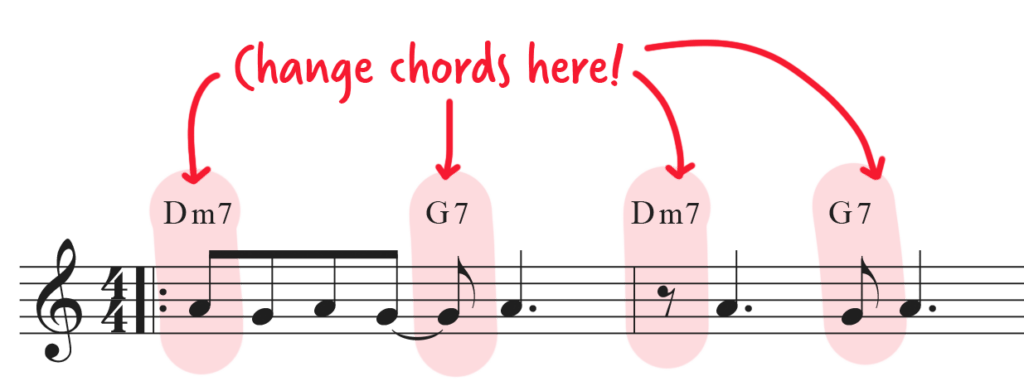If you want to learn how to play jazz piano but are not sure where to start, you’ve come to the right place! In this beginner jazz lesson, we’ll cover the absolute basics any aspiring jazz pianist should know: swing rhythm, the 2-5-1 chord progression, comping rhythms, and how to read a lead sheet and apply these concepts.
Now, jazz piano isn’t easy! But it sounds so good and is so rewarding. We want you to get excited about playing jazz piano, so this lesson is suitable for anyone, even folks new to piano.
Table of Contents:
Inspiring tutorials. Fascinating articles. Exclusive interviews. We create piano content anyone, anywhere can enjoy for free. Don’t miss out, sign up for more free lessons.
You can download the exercises we’ll use in this lesson right here:
Pianote Members can also download the lead sheet to “Satin Doll.” If you’re not a Member yet, no problem! Here’s a seven-day trial just for you:
Rhythm is an essential part of jazz. While classical and pop music tend to follow a “straight” rhythm, jazz rhythm is swung. This means you linger a little on a beat.
So, if a straight rhythm goes like this:
1 + 2 + 3 + 4 +
A swing rhythm goes more like this:
1… + 2… + 3… + 4… +
You can think of this as playing long-short, long-short, etc.
The easiest way to understand swing is to feel it. Listen to some jazz and move with the beat!
For the theory nerds, what we’re essentially doing is playing two eighth notes like the first and last note of a triplet. You can also think of it as a quarter note followed by an eighth note in the space of a triplet.

Try playing the C major scale in a swing rhythm. Here’s a C major scale in repeated eighth notes with fingering.

Another pillar of jazz piano? The 2-5-1 chord progression.
This is a chord progression built on the second, fifth, and first notes of the scale. So, if we’re in C major, we build chords on D, G, and C and apply C major’s key signature to them. When we do this with seventh chords, we get:
Dm7 – G7 – Cmaj7
The easiest way to transition between these chords is by using inversions. Try this:

Need a little more time? The 2-5-1 chord progression is a core jazz concept and is worth extra practice. If you’re new to chords and chord progressions, check out these lessons:
A comping rhythm is a rhythm you play with your chords to accompany a song. Here’s a classic jazz comping rhythm you can use with your 2-5-1 progression. Notice we play the first chord of the measure on the “and” or off-beat.

This is just one example of a comping rhythm. There’s an infinite variety of comping rhythms you can play on the piano. Try making up your own, or listen to your favorite tunes for some inspiration. You can also get inspiration from your rhythm section if you’re playing with a group.
If you’re used to playing sheet music arrangements for solo piano, lead sheets may look a little different! But they’re quite simple to read.
A lead sheet shows the melody of a song and chord symbols where chords change.

The most straightforward way to play a lead sheet is by playing the melody with your right hand and the chords with your left. It’s usually a good idea to master this basic way of playing before you add fancy stuff like improvisation and reharmonization.
Reading lead sheets requires some knowledge of chord symbols. We have an in-depth cheat sheet/guide, but here’s a quick rundown of what common chord symbols mean:
| Chord Type | Chord Symbol (Example) | Notes (Example) | Theory |
|---|---|---|---|
| Major 7th Chord | Cmaj7 | C-E-G-B | Major triad with an added major 7th interval. |
| Minor 7th Chord | Dm7 | D-F-A-C | Minor triad with an added minor 7th interval. |
| Dominant 7th Chord | G7 | G-B-D-F | Major triad with an added minor 7th interval. |
| Diminished 7th Chord | D#dim7 | D#-F#-A-C | Stack of minor thirds. |
Learn more about different types of 7th chords here.
🎼 How to Get Lead Sheets: Most lead sheets are copyrighted and will cost a few dollars, but you can download them online through sites like Sheet Music Direct, Musicnotes, or Musescore. You can also buy a Real Book, which is a compiled “bible” of the most popular jazz standards.In this lesson, you’ve learned some neat jazz skills. Specifically, you’ve learned how to:
Now let’s put these skills towards learning our first jazz standard: “Satin Doll” by Duke Ellington.
First, get to know your right-hand melody. There’s some tricky counting in this song because there’s a lot of syncopation, so if you get stuck, try breaking the rhythm into smaller units. You’ll notice that we land on some notes on the off-beat (the “and”). In jazz, we call this a push.

Before we put our hands together, get your left-hand chords solid too. Practice transitioning between the chords and if you’re using inversions, practice those.
You’ll notice that there are a few 2-5s in this song. They are:
Practice transitioning between these chords. You’ll find 2-5-1s everywhere in jazz (“Autumn Leaves,” “Summertime,” “Fly Me to the Moon” etc.), so being able to play these shapes in your sleep will go a long way!
Next, put your right and left hands together. This requires some skill in hand independence, so if you’re a beginner, it will take some time. But you’ll get it, we promise! It just takes practice.
At this point, you’ve got the basics and it’s time to have fun.
Remember that comping rhythm we learned for the 2-5-1 progression? Try using that with “Satin Doll.”
And when you’re ready, try improvising over the form.
The wonderful thing about jazz is that you can take a simple melody and make it your own. The lead sheet to “Satin Doll” may look simple, but there is so much you can do with it. To get inspired, look up expert jazz pianists playing their own take on the song. For example, watch how Oscar Peterson uses rhythmic variety, dynamics, scales, glissandos, tremolos, and more in his rendition.
Happy practicing!
The best way to learn piano is with real teachers, but not everyone has the time and money for a private instructor. At Pianote, you can get real feedback from real experts…all from the comfort of your own home. Explore our Method and community yourself with a free 7-day trial.
TRY PIANOTE FOR 7 DAYSKevin Castro is a graduate of the prestigious MacEwan University with a degree in Jazz and Contemporary Popular Music, and is the Musical Director and touring pianist for JUNO-winning Canadian pop star, JESSIA. As your instructor at Pianote, Kevin is able to break down seemingly complex and intimidating musical concepts into understandable and approachable skills that you can not only learn, but start applying in your own playing. Learn more about Kevin here.
/marketing/pianote/promos/april/banner-bg-m.webp)
We use cookies for traffic data and advertising. Cookie Policy »
/marketing/pianote/promos/april/banner-title.webp)